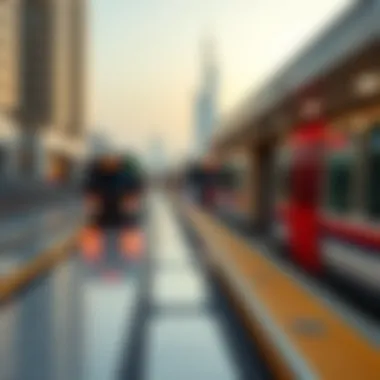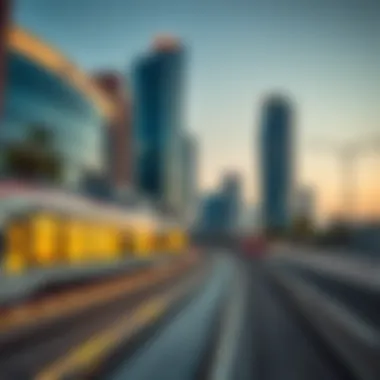Dubai Metro 2025 Developments and Real Estate Impact


Intro
The Dubai Metro system has grown into a cornerstone of the city’s infrastructure, connecting diverse neighborhoods while playing a significant role in shaping the urban landscape. As we look towards 2025, several developments within this public transportation network signal not just progress in mobility, but also a substantive shift in the real estate market. Bursting forth with renewed energy, planned expansions promise improved connectivity and easier access to key areas, thereby enhancing property values and presenting new opportunities for investors and residents alike.
Grappling with the current state of Dubai’s real estate, we now confront questions that strike at the heart of any investment decision: How will the upcoming changes to the metro system affect market dynamics? What opportunities could arise from greater accessibility? This discussion promises to unfold in a way that is both engaging and insightful, offering a glimpse into the future of Dubai’s real estate ecosystem.
Overview of Dubai Metro
The Dubai Metro system stands out as a remarkable feat of urban engineering, fundamentally reshaping the public transportation landscape in the city. Introduced in 2009, it has offered residents and tourists a swift alternative for traversing the bustling metropolis. Understanding the potential developments of this system is critical for grasping its profound implications for the real estate sector as we approach 2025. As urban expansion continues, the metro provides not just convenience but also drives property value fluctuations, affects neighborhood dynamics, and shapes investor interests.
Historical Background
When we look back, the journey of Dubai Metro is intriguing. Planning began in the late 1990s, with the vision to create a modern transport system that would alleviate traffic congestion and promote sustainable urban growth. By 2001, the project was officially underway, culminating in the launch of the Red Line in September 2009, followed by the Green Line in 2011. The initial success was staggering, boosting public transport use and setting the stage for further expansions. In many ways, it has become the lifeblood of the city, linking major districts and facilitating economic activity across varied sectors.
Current Metro Lines and Stations
Currently, there are two primary lines: the Red Line and the Green Line. The Red Line stretches approximately 52 kilometers, with 29 stations, linking key areas like the Dubai International Airport, Downtown Dubai, and the Dubai Marina. The Green Line, shorter at about 22 kilometers, presents 20 stations, connecting many residential areas to commercial hubs.
Moreover, each station is equipped with modern amenities, and features art installations reflecting Dubai’s rich culture. With the specifications of these lines, it’s crucial to note how the metro supports the community, making it easier for residents and visitors alike to access employment, shopping, and recreation without the need for burdensome car rides. This unprecedented level of connectivity nurtures a sense of community and paves the way for further urban development.
Usage Statistics
In terms of usage, the figures paint a revealing picture. The metro attracts a substantial number of daily passengers, with ridership statistics surpassing 500,000 on average before the pandemic. Upcoming expansions are expected to boost these numbers even further.
- Average daily riders: Over 500,000
- Monthly ridership: Approximately 15 million
- Projected growth by 2025: An expected increase of 20-30% as new lines open
These statistics underline the metro's role as a facilitator of urban mobility, but they also raise important questions about the correlation between metro accessibility and real estate values. It’s a relationship that any potential homeowner or investor in Dubai should keep a keen eye on, as the expansion of the metro network could represent golden opportunities for property investment as urban spaces evolve.
"Understanding the evolution of the Dubai Metro is essential for grasping its future impact on property dynamics."
Future Plans for the Dubai Metro by
As we glance into the future of the Dubai Metro, it's crucial to recognize how these plans shape not only public transportation but the very fabric of real estate development. The anticipated enhancements hold promise for better connectivity and increased accessibility, which can lead to a surge in property values and attract more interest from investors. Cities that prioritize efficient public transit systems tend to flourish economically, and Dubai aims to lead the pack.
Proposed New Lines
One of the most exciting features in the plans for the metro is the introduction of new lines. Among these, the Dubai Metro Purple Line stands out as a promising addition, to stretch from the Dubai Marina to Downtown areas, linking neighborhoods and business hubs. This line is poised to cater to a diverse demographic, enhancing travel for tourists and residents alike. Furthermore, there’s talks of integrating more express lines that might streamline travel times significantly, reducing congestion on roads and lending commuters more time back in their busy lives.
These planned additions come with their own set of considerations. Local businesses near proposed stations may see foot traffic soar, creating fresh opportunities for commercial investments. However, how quickly these developments materialize will largely depend on funding and logistical efficiency.
Extensions to Existing Lines
In addition to new lines, the extensions to existing ones will further cement Dubai's reputation as a transit-oriented city. For instance, the Green Line is expected to be extended to reach new residential areas, making previously isolated neighborhoods accessible. An enhanced Metro network can translate to greater demand for housing in these regions, fueling real estate prices over time. Properties in well-connected zones typically fetch higher premiums, making this a significant factor for investors to keep an eye on.
Moreover, extensions bring with them the potential to revamp local infrastructure, from roads to amenities, thereby enhancing overall property attractiveness. Folks love the convenience that public transport offers, and simply put, where the metro goes, investments tend to follow.
Timeline for Construction and Operation
The timeline for these ambitious projects is as critical as the proposals themselves. According to the latest reports from the RTA, the construction of new lines and existing line extensions is slated to commence in the next year or two. There could be phased rollouts with certain sections opening up ahead of others to provide immediate benefits to the commuting public. The operational target for a good number of these expansions is planned for the end of 2024, with hopes that most will be fully functional by 2025.
It's essential for investors and stakeholders to remain updated on these timelines as delays can alter property values significantly. If a prospective area is suddenly under construction for an extended period, it might affect current pricing, leading to potential buying opportunities or caution in investment.


Effective transportation networks are the backbone of urban development, bringing about not just ease of movement, but significant economic growth.
The expected developments in the Dubai Metro by 2025 are not just parking lots filled with shiny new trains; they encapsulate the very notion of urban evolution. The successful implementation of projects hinges not solely on construction; it's intertwined with how communities embrace and adapt to these changes in their daily lives. Thus, closely monitoring these developments can provide valuable insights into future investment opportunities.
Impact of Metro Expansion on Real Estate
The expansion of the Dubai Metro is set to transform not just transit but also the city’s real estate landscape. With the new developments slated for 2025, the implications ripple through diverse sectors of the market, positioning the metro system as a major player in reshaping property dynamics.
Changes in Property Values
As the metro lines stitch new routes across the city, property values near stations are expected to rise significantly. Historical data points to a pattern: properties within close proximity to metro stations have traditionally commanded higher prices; homebuyers often prioritize access to public transit in their search criteria. For instance, the Discovery Gardens area, which already showcases a hike in its dwelling prices due to its accessibility, stands as a testament to this trend.
Furthermore, with increasing convenience, homes near new metro stations are anticipated to attract a broader buyer demographic, including expatriates seeking ease of commute to work. It’s plausible that prices might escalate beyond just immediate areas, creating a ripple effect on property values in neighboring locales as demand intensifies.
Neighborhood Transformation
The arrival of new metro lines not only boosts property values but also catalyzes profound shifts within neighborhoods. Districts adjacent to metro stations often experience a revitalization; retail spaces, restaurants, and entertainment venues sprout, drawn in by the uptick in footfall and an enhanced communal atmosphere.
For instance, areas like Al Qusais and Al Nahda, both of which will see metro extensions, will likely transition into buzzing hubs where everyday conveniences mingle harmoniously with new cultural offerings. The transformation nurtures a younger, more vibrant community, eventually attracting families and young professionals.
Moreover, this revitalization often entails improving infrastructure, as local authorities invest in additional amenities and public services to support the rising populace. Residents will find not just homes but rich neighborhoods fostering connectivity and recreation.
Investment Opportunities Near Metro Stations
As the Dubai Metro expands, astute investors are presented with golden opportunities. Properties in the orbit of new metro stations can yield substantial returns, whether for buy-and-hold strategies or for immediate rental investments. The shifting dynamics render previously overlooked locations appealing due to their newfound accessibility.
Investors might consider purchasing properties for residential rental investments, particularly in areas predicted to perceive an influx of young renters and expatriates. Emerging neighborhoods, like Jumeirah Village Circle, are already being eyed due to their strategic positioning along future metro routes.
In addition to residential options, commercial real estate near metro stations shows plenty of promise. Businesses are more likely to set up shop catering to the heightened demand for services from new residents and commuters. Opportunities abound, ranging from office spaces to retail outlets, creating an ecosystem that aligns with the anticipated increase in foot traffic.
"The planned metro expansions are not merely infrastructural changes; they act as magnets for growth and investment, turning the spotlight on previously undervalued areas of Dubai."
Accessibility and Connectivity Improvements
In urban development, accessibility and connectivity are vital components that can significantly shape the residential and commercial landscape. The planned enhancements to Dubai's Metro system are not merely about expanding the reach of public transport; these improvements hold the potential to redefine how communities interact with one another and how the real estate market evolves in response.
Enhanced Links to Key Areas
As Dubai continues to grow, the need for efficient transportation that connects vital sections of the city becomes paramount. The new metro expansions plan to create strategic links to key areas, like business districts, shopping hubs, and residential neighborhoods. For instance, establishing a direct metro line to the bustling Dubai Marina or the historic Dubai Creek can encourage foot traffic in commercial zones, boosting retail sales.
Moreover, this enhanced connectivity is beneficial for professionals commuting to the Financial Center. A seamless link reduces travel time, making it more appealing for families to settle in areas once deemed less accessible. This not only benefits daily commuters but also opens the door for long-term investment opportunities in real estate sectors previously overlooked.
Integration with Other Transport Modes
Creating a public transit ecosystem means more than just enhancing one form of transportation; it's about knitting together various modes to ensure fluid movement across the city. By integrating metro lines with bus networks, taxis, and rideshare services, commuters can enjoy an uninterrupted travel experience. Imagine stepping off a metro train and finding a bus waiting to whisk you away to your final destination. This kind of synergy can inspire more people to forgo their cars, leading to reduced traffic congestion.
Furthermore, this interconnectedness is essential for real estate developers. Properties near metro stations, bus interchanges, or tram lines tend to attract higher demand, often reflecting positively on property values. Locations strategically chosen due to their transport links allow savvy investors to capitalize on the growing emphasis on connectivity.
Influence on Expat Relocation
Dubai's status as an expat haven continues to rise, largely due to well-planned urban infrastructure. The expansion of the metro plays a significant role in attracting expatriates looking for convenience and ease of living. A robust metro system offers a compelling alternative to driving, which is particularly appealing to those unfamiliar with the local roads and driving style.


Expatriates value communities where their daily needs are conveniently met. Areas with metro access are often favored for housing, as they provide easy routes to workplaces and leisure spots. Consequently, neighborhoods, which were once on the outskirts, can see a spike in interest as the metro opens new avenues for accessibility.
Environmental Considerations of Metro Projects
In the midst of rapid urban expansion and development, the sustainability of infrastructural projects becomes paramount. This section sheds light on the environmental considerations surrounding the Dubai Metro's expansion, particularly as it gears toward significant developments by 2025. Understanding these aspects not only demonstrates the commitment to ecological responsibility but also addresses the concerns of residents and prospective stakeholders. With increasing awareness of climate change and urban pollution, the integration of environmentally-friendly practices is becoming a benchmark for how cities approach public transportation developments.
Sustainable Construction Practices
Sustainability begins with how the metro is built. Implementing sustainable construction practices means that from day one, efforts are made to minimize harm to the environment. For instance, using recycled materials for railroad tracks and station structures can significantly reduce waste. Metro projects in Dubai are adopting modern technologies like modular construction, which not only accelerates building time but also minimizes resource consumption. Moreover, strict regulations guide developers, encouraging the use of solar panels on station roofs which can significantly lessen energy reliance from the grid.
- Efficient Energy Use: By deploying energy-efficient technologies within new stations, these practices result in lower operational costs and reduced carbon footprints.
- Water Conservation: Implementing systems that recycle water for landscaping and other purposes decreases the demand for fresh water, crucial in arid climates.
Reduction in Traffic Congestion
With an increase in population and the corresponding rise in vehicle ownership, traffic congestion continues to plague Dubai. The metro expansion is designed primarily to alleviate this problem, providing an efficient alternative to road travel. By channeling more commuters onto public transport systems, the reliance on personal vehicles decreases.
"The metro being extended means less gridlock on the streets. It makes a notable difference during peak hours."
The ripple effect of reduced traffic congestion is substantial. It not only enhances traveler experience but also promotes a more pedestrian-friendly environment. Reducing the number of cars on the road means less wear and tear on road surfaces, contributing not just to reduced maintenance costs for the government but also leading to lower emissions from idling vehicles. Pursuing this path means that existing traffic hotspots can potentially become vibrant urban spaces, allowing for recreational areas that foster community engagement.
Air Quality Improvement Efforts
Air quality is a significant concern in urban centers, and the expansion of the Dubai Metro operates as a vital measure toward improvement. By promoting public transportation, there’s a proportional decrease in the number of cars on the road, which directly correlates with decreased air pollution levels. The transition to electric trains further supports the endeavor to reduce air pollutants emanating from traditional fuel-powered transportation sources. As the metro lines expand, residents can breathe easier.
- Monitoring Air Quality: Advanced technologies are being implemented to evaluate the impact of metro operations on local air quality. Continuous monitoring systems provide crucial data, facilitating informed decisions for future enhancements.
- Public Awareness Campaigns: Initiatives aimed at informing residents about the air quality benefits linked to increased metro usage help foster community buy-in and encourage more people to make the switch.
The environmental considerations surrounding the Dubai Metro improvement initiatives underline their broader impact beyond mere transport efficiency. They pave the way for a greener, more sustainable urban ecosystem that not only accommodates growth but prioritizes community, health, and environmental stewardship. These efforts will resonate with investors, real estate professionals, and potential residents who are looking for sustainable living solutions in bustling metropolitan atmospheres.
Challenges Facing the Metro Expansion
The expansion of the Dubai Metro is not without its hurdles. Understanding these challenges is essential, especially for those invested in the region's real estate market. Metro expansions can transform neighborhoods, influence property values, and boost accessibility, yet the road to completion is often fraught with complications that can affect both the timeline and effectiveness of these projects. Exploring the reasons behind these issues is crucial for investors, agents, and home buyers looking to navigate the evolving landscape of Dubai's real estate.
Funding and Budget Constraints
Funding remains one of the biggest challenges for the Dubai Metro's expansion. The costs associated with the construction of new lines and the upgrading of existing infrastructure can be mind-boggling, stretching budgets thinner than a dime store sandwich. Government resources can sometimes be stretched too far, leading to tough decisions. While the UAE has considerable wealth, prioritizing transportation investments against other pressing needs can lead to delays and modifications in project scopes.
- Limited Public Funds: The government competes with education, healthcare, and social services for a slice of the budget pie.
- Dependence on Private Investment: Attracting private investors can be tricky, particularly in an uncertain economic climate.
- Cost Overruns: Unexpected geological or logistical issues can result in significant unbudgeted expenses.
Construction Delays and Their Impact
Construction delays can raise considerable eyebrows in the real estate market. When projects lag behind schedule, it not only impacts the transportation network but also slows the anticipated economic benefits that come with it. Buyers and investors often look for a clear path of development, and if that slows down, so does their confidence.
- Logistical Challenges: Importing materials, managing traffic, and dealing with urban infrastructure can result in unforeseen slowdowns.
- Project Re-evaluation: Sometimes, mid-project assessments reveal modifications are needed, further pushing timelines back. This can halt progress in areas already ripe for development, leaving neighborhoods in a kind of limbo.
Consequently, such delays can impact property prices; potential buyers may be hesitant to invest in areas without a clear timeline for improvement.
Public Sentiment and Community Opposition
The expansion projects often encounter friction at the community level. Local residents and businesses may have concerns about construction disruptions, environmental impacts, and changes to the neighborhood they cherish. While many understand the long-term benefits, the short-term inconveniences can stir up dissatisfaction.
- Community Meetings and Protests: Organizing public forums can exacerbate concerns, especially if there’s a perception that voices aren’t being heard.
- Concerns Over Property Values: Existing residents often fear their property values will be negatively impacted during the construction phase.
- Disruption to Local Businesses: Small business owners near construction sites may feel squeezed out as foot traffic wanes due to road closures and detours.


Comparative Analysis with Global Cities
Understanding the developments in the Dubai Metro system for 2025 can be more profound when juxtaposed with metro systems in other major global cities. This comparison provides insights into best practices, challenges, and innovative strategies that can be essential in shaping the future of public transport and real estate in Dubai. By examining global case studies, we can draw parallels and contrasts that illuminate how Dubai’s metro expansion could impact its real estate scene.
Metro Systems in Major Global Cities
Cities like New York, London, and Tokyo boast expansive metro systems that serve millions daily. These systems not only reduce traffic congestion but also play a crucial role in shaping urban development.
- New York Metro: Known for its extensive reach, the New York City subway is one of the busiest in the world, with over five million riders daily. The interconnectedness of the system has significantly influenced housing demand, particularly around transit hubs.
- London Underground: The Tube is famed for its efficiency and historical significance. The property prices around new ‘Crossrail’ stations increased, showing how metro expansions can spur real estate growth.
- Tokyo Metro: Tokyo’s sophisticated metro network connects diverse suburbs to bustling city centers, maintaining high property values in well-connected areas. The punctuality and high service standards offer lessons for operational improvements in Dubai's metro system.
These cities exemplify how effective metro systems can drive urban sprawl and increase property values. For potential investors and real estate agents in Dubai, understanding these models explains the potential trajectory of property values and residential demand near upcoming metro stations.
Lessons Learned from International Examples
From the experiences of global cities, several key lessons can be distilled for Dubai's metro expansion:
- Integrated Transport Solutions: Cities that have successfully integrated various forms of transport see better overall outcomes. Dubai could benefit from seamless connections between metro, bus, and tram services.
- Predictable Development Patterns: Real estate values often correlate with proximity to metro stations. Developing policies that encourage high-density housing around these hubs could attract more residents.
- Sustainability Focus: Sustainable practices in construction and operation, as seen in cities like Copenhagen, can enhance the environmental benefits of metro expansions. This can resonate well in Dubai's forward-thinking plans regarding sustainability.
Understanding how these elements play out in established metro networks can inform stakeholders in Dubai's real estate sector on anticipated changes in the market landscape, as the metro network reaches further into new neighborhoods and develops further in existing ones.
"Cities that adapt their urban planning to include robust public transport will ultimately thrive in the coming decades, and Dubai stands at the precipice of such transformative growth."
As Dubai moves forward with its ambitious metro plans, keeping an eye on global best practices can provide invaluable insights, ensuring the city not only fosters robust real estate development but also creates a sustainable and vibrant urban environment.
Future Outlook for Dubai Metro and Real Estate
The Dubai Metro is poised to become a catalyst for change in real estate as the city looks to enhance its public transport offerings by 2025. The envisioned expansions aren’t just about laying new tracks; they represent a long-term vision aimed at reshaping how residents, investors, and businesses experience urban mobility. A key consideration is that improved public transport networks generally lead to higher property values and attract diverse populations to previously underutilized neighborhoods.
In this ever-evolving urban landscape, the metro's growth is expected to usher in new commercial and residential projects, particularly near upcoming stations. This connectivity will substantially appeal to a broad range of stakeholders from expatriates looking for convenient cycling options to real estate investors scanning for lucrative opportunities.
"A robust public transport system is an invaluable asset that enhances not only accessibility but also quality of life within a city."
Long-term Vision for Public Transportation
The long-term vision for the Dubai Metro encapsulates numerous elements designed to integrate seamlessly into the daily lives of its users. The focus on sustainability is evident, as the authorities aim to minimize the carbon footprint of expansions. Initiatives like solar-powered stations and energy-efficient trains are underway, all while maintaining the metro's reputation for punctuality and efficiency.
An equally crucial aspect is the strategic alignment with urban development plans. Improving the transit infrastructure to reach underdeveloped areas will not just serve the current population; it sets the stage for future growth by making these neighborhoods more appealing to prospective buyers. As new metro lines are added, they will effectively bridge gaps in connectivity, thereby enhancing the allure of the surrounding real estate.
- Improved access to healthcare facilities and educational institutions
- Reduction in commute times, making areas more desirable
- Potential for mixed-use developments that combine residential, commercial, and recreational spaces
Future Trends in Urban Development
As the Dubai Metro expands, several future trends in urban development are expected to emerge. Mixed-use developments will gain traction as urban planners and investors seek to create environments where living, working, and leisure coexist harmoniously. This trend not only boosts property values but also enriches community life.
The shift towards smart city initiatives, encompassing technologies like app-based transport solutions and real-time tracking systems, will revolutionize how residents interact with their environment. With smart transit options, property buyers will seek homes that boast easy access to metro stations and minimal reliance on private vehicles.
- A surge in demand for eco-friendly and sustainable living spaces
- Focus on community-oriented developments that include parks, bike paths, and pedestrian-friendly areas
- Increasing popularity of properties offering easy transit options as a key selling point
End
As we explore the developments set to reshape the Dubai Metro by 2025, it becomes clear that the impact extends far beyond transportation. Adjustments in the metro layout and the addition of new lines can significantly alter the fabric of real estate in the city. Investors and homeowners alike must keep a keen eye on these changes, as they could very well dictate the future of property values and the urban experience in Dubai.
The improvements planned not only enhance convenience by reducing travel time and creating seamless connections across cities but also encourage the growth of local businesses around new stations. Properties in proximity to these stations generally see an increase in demand, making them attractive investments. In particular, areas that were previously underserved will likely experience a renaissance, drawing both expatriates and locals attracted to convenience and community.
"Strong correlation exists between metro stations and increased property values. The convenience factor becomes a significant driver for homebuyers and investors."
Key considerations include understanding the trajectory of these developments. Identifying neighborhoods poised for growth can yield profitable investment opportunities. Additionally, the reduced reliance on personal vehicles aligns with global trends toward sustainable living—a factor gaining prominence among discerning buyers.
Ultimately, the enhancements to the metro system represent more than just a transit project; they’re part of a larger vision for a more connected, vibrant Dubai. Stakeholders in the real estate market must adapt to these exciting changes, leveraging insights gained from the ongoing developments to make informed decisions. As the 2025 horizon approaches, being proactive and informed will separate successful investors from the rest.











